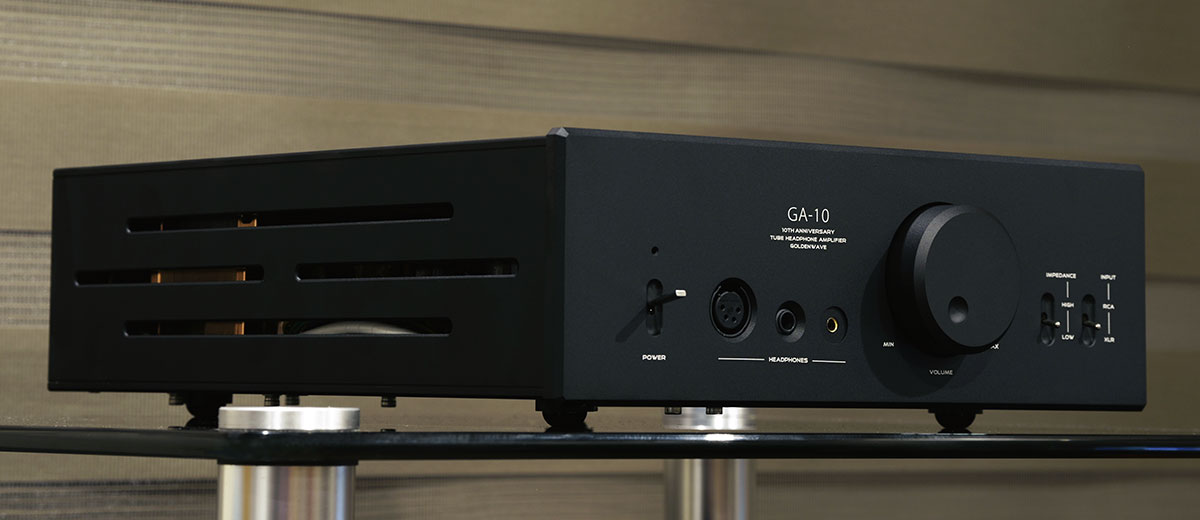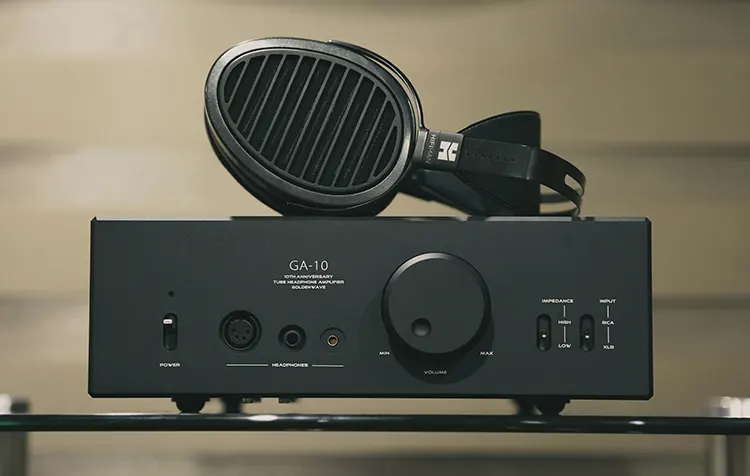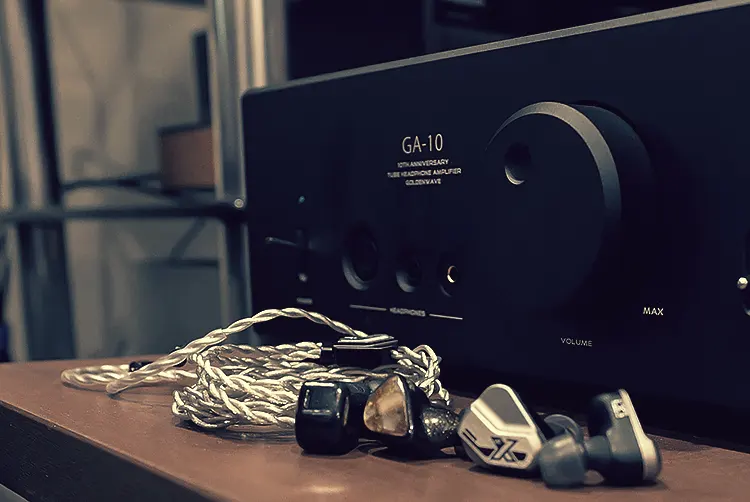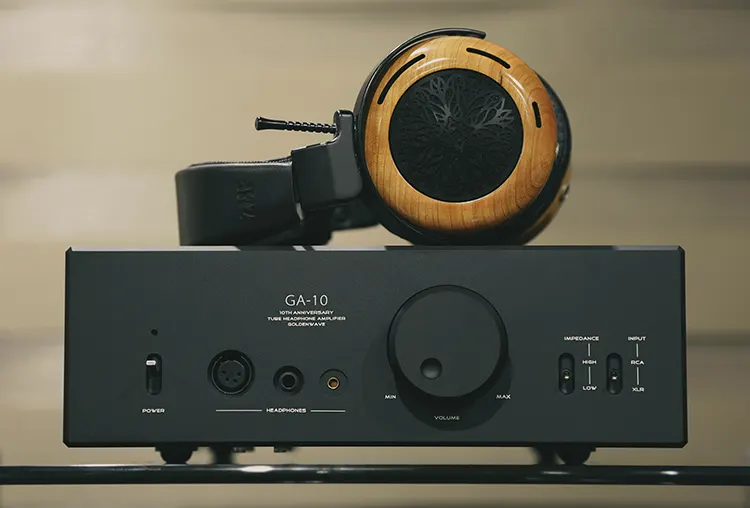Sound Impressions
The following comparisons to the HIFIMAN Goldenwave GA-10 were completed using a mix of the HIFIMAN Serenade and Ferrum’s WANDLA GSE in balanced lineout mode for my primary sources.
My selected headphone pairings included the HIFIMAN Arya Stealth Magnet Edition, ZMF Headphones’ Atrium Open, and the Austrian Audio The Composer.
Summary
There are many types of tube presentations, so whilst the GA-10 has an unmistakably tube amp sound, it’s clearly different from some of the competing amplifiers we have here in the office.
Of all the similarly priced (and some more expensive) amplifiers compared, the GA-10 has the most impressive soundstage qualities, sounding very wide, very holographic, with excellent resolution and dynamic range when fed with suitably competent DACs.
There is a degree of transparency from the GA-10 with sources. I found the HIFIMAN Serenade to introduce more warmth and a richer tone compared to the more neutral but elegant micro-detailing of the Ferrum WANDLA GSE.
And yet, neither DAC dramatically affected the ability of the GA-10 to project that sense of space and excellent instrumental/vocal separation.
If there is a commonality among all of the fed sources, then it is a smooth, almost sweet-sounding, and airy presentation from the GA-10. Nothing sounds sluggish, or like ‘walking through molasses’. It’s not a dark tuning, not too bloomy on the lows, with a subtle level of treble sparkle contributing to an agreeable midrange tone.
If you are using high impedance headphones such as the 300Ω ZMF Headphones Atrium, you will appreciate just how well the GA-10 can handle this headphone’s penchant for big soundstage performances.
And speaking of load, yes, the GA-10 excels on high-load headphones, that is its forte. However, lower impedance planars such as the Arya Stealth Magnet Version and, surprisingly, a lot of IEMs will work well with the GA-10’s very low noise floor and almost black background.
Super demanding planars with lower impedance values, such as the Susvara (og), might be a stretch too far, with noticeable distortion at certain loudness levels.
Coloration
The GA-10 tuning is an almost effortless, yet very clear and resolving sound signature for a tube amplifier at this price point. It’s not as weighty or as thick as the HA-2A on the lows, nor is it as upfront and driven-sounding as the Auris Audio HA-2SE+.
This is a lighter tone on the lows, mixing a sensible level of bass weight, mid-bass punch, and quality layering on all of the headphones tested. Its key strength in the lows is definition with a natural decay but not one that carries a lot of bloom, creating welcome space for the mids to shine.
The mids have a beautifully separated sound with a slightly relaxed and sweetened vocal timbre, but one that is precisely positioned ahead of background instruments.
The overall note weight has a lighter quality than the aforementioned amps, with a more balanced, even-harmonic overtone, less bass bloom, and more brilliance from a very subtle treble overlay on the instrumental and vocal timbre.
The treble tone can shift a bit depending on the impedance selection. I found the high-gain impedance to introduce a more dynamic and impactful sound, but at the cost of some stronger upper-mids and treble presence, particularly with the Arya Stealth.
I much preferred the more relaxed, coherent, and smoother tones of the lower impedance mode with easier-to-drive neutral to slightly bright headphones.
The Atrium Open’s higher impedance rating naturally lends it to the high impedance selector mode, but beyond, the tonally stronger treble presence gives it a welcome boost in timbral contrast.
DACs will color the GA-10 sound also. The Serenade adds some additional bass bloom and vocal richness. Whereas the WANDLA GSE is slightly more neutral in tone, tightening up the decay and little and enhancing the overall clarity.
Staging & Dynamics
Spacious, the singular definition of my instant impressions of the GA-10’s staging capability. Throw in excellent dynamic range and a surprisingly excellent low noise, and a black background for IEMs, and you have an excellent presentation for a wide range of headphones.
Arguably, other amps have more weight and punch on the low end, at least with this combination of tubes inside the GA-10. If there is one critique of the GA-10’s stock tube combination is that despite the excellent extension, it is a little bit light in body on the lows.
I am not entirely sure I would want the GA-10 to change course and start going down that same ‘fat and slow’ direction, given that I find the bass response to sound quite balanced. Having less bloom and better definition is appreciated.
Of the three amps compared on page 3 of this review, none have the same staging width or type of airy headroom that the GA-10 can offer. At times, the nuanced treble articulation borders on the ethereal, especially with the WANDLA GSE as its source.
If you have a very open-sounding set of headphones, such as the Atrium, the GA-10 will do better than most in presenting a large holographic soundstage for those headphones to gobble up.
Synergy
Noise Floor
The HIFIMAN GA-10 is rated at up to 3W for output power, but on the high load side at 300Ω, dropping progressively down to a more modest 600 mW on the same load.
That should be plenty for most dynamic driver headphones at all impedance levels. Especially with the included impedance high/low switch, which, beyond impedance output levels, gives you a nice degree of control over the final tonal quality with each headphone pairing.
The big surprise is the excellent low noise floor on the GA-10 for sensitive IEMs. I was not expecting a huge amplifier like this to have the finesse to handle low impedance sensitive gear, but not only is there very little background hiss, but the amount of useable volume and headroom is very good indeed.
Only when I switched to high impedance with IEMs such as the Vision Ears VE10 could I hear a very faint audible signal on zero volume, and in low impedance mode I could get at least a third of the volume dial in use, giving me some welcome control over the IEM’s loudness levels.
I would say, however, the GA-10 presentation better suits a spacious-sounding IEM with a balanced bass response such as the PMG Audio Apx. This delivered a very smooth and refined presentation with excellent width and a pure treble tone.
I suspect the lowest output impedance of the GA-10 is much higher than 1Ω, as I do hear some wooliness in the VE10’s dynamic driver performance on the low impedance setting. Switching it to high dampens the bass and pushes the treble much further forward, giving it a harsher sound in the upper-mids.
Headphone Pairings
I went through several pairs, so let’s get the elephant in the room out of the way first. The GA-10 cannot drive the Susvara OG that well. It can get loud, but the sound distorts around 2 pm on the volume dial.
This result did not surprise me, given the drop in the GA-10’s output power and the Susvara’s 60Ω impedance rating, where the headroom is much more limited.
The better HIFIMAN headphone pairings reside around the Arya series, with the Arya Sealth Magnet Version providing a spacious and resolving sound signature.
Choose the low impedance output switch here for a calmer sound. The high impedance was more immediate in the mids but stressed the upper-mids too much, giving it a harder-edged tone.
The bigger debate with this setup was the DAC behind it, of which I tried two: the HIFIMAN Serenade and the Ferrum WANDLA GSE. The Serenade narrowed the soundstage with less separation but thickened the vocals and bass to produce a weightier performance than the WANDLA GSE.
However, the GSE had the better tonal balance, the more holographic soundstage, and improved on clarity and separation. It’s a more expensive DAC for sure, but fed into the GA-10, it lived up to its reputation with the Arya Stealth.
High impedance headphones, such as the ZMF Headphones Atrium, sounded great with the GA-10 with loads of headroom. These headphones have a very spacious soundstage, with the GA-10 consistently able to better fill it than competitors such as the HA-2A and the Auris Audio HA-2SE+.
Even the HD 800 sounded pleasingly wide, though again, I might pick the Serenade DAC over the WANDLA GSE to enhance the warmth and richness at the cost of that excellent fidelity from the Ferrum unit. That’s purely a preference thing, so YMMV.





